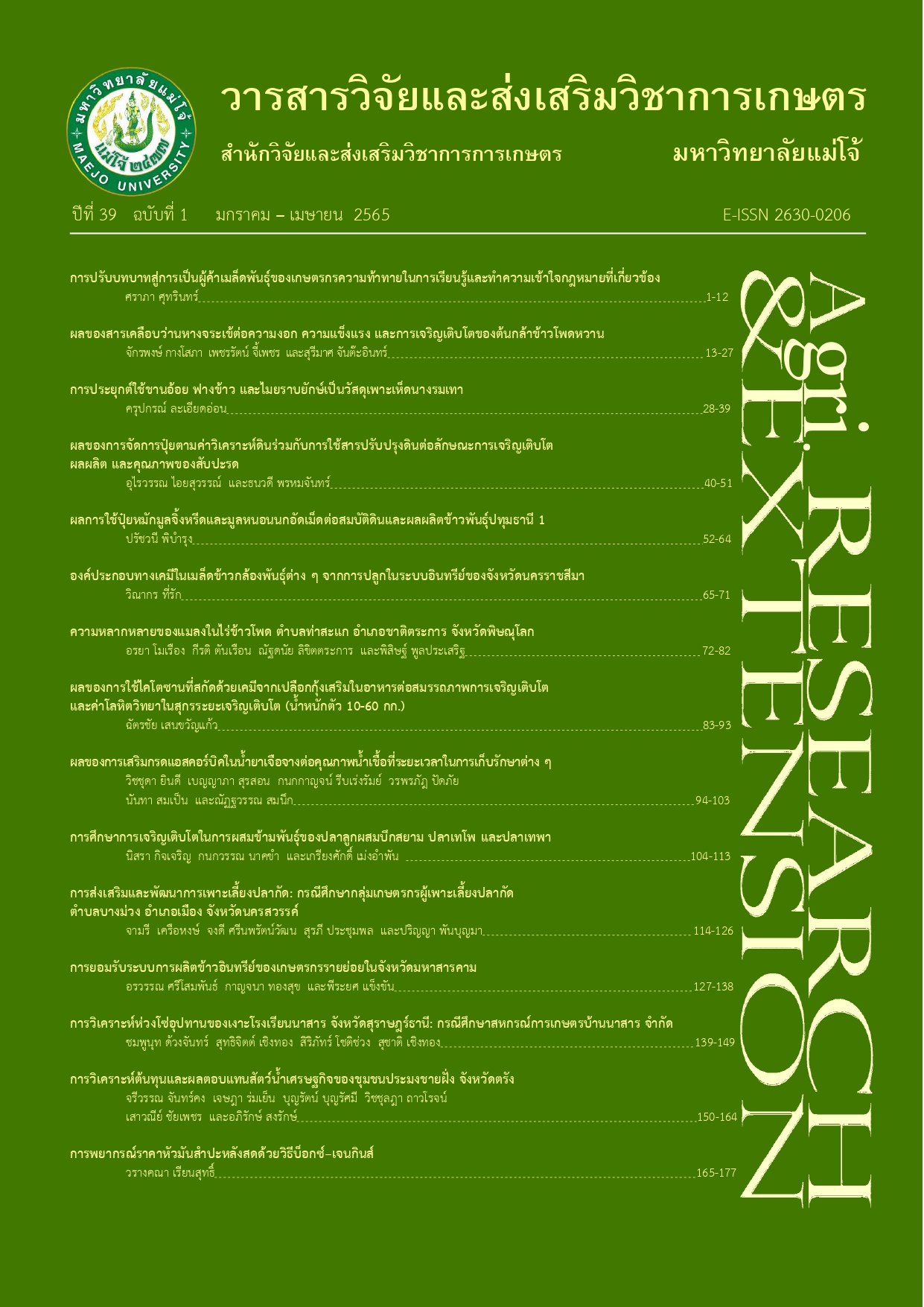การประยุกต์ใช้ชานอ้อย ฟางข้าว และไมยราบยักษ์เป็นวัสดุเพาะเห็ดนางรมเทา
คำสำคัญ:
เห็ดนางรมเทา, ชานอ้อย, ฟางข้าว, ไมยราบยักษ์ , วัสดุเพาะบทคัดย่อ
การวิจัยนี้มีวัตถุประสงค์เพื่อศึกษาวัสดุเพาะ จากชานอ้อย ฟางข้าว และไมยราบยักษ์ ซึ่งเป็นส่วนผสมที่มีผลต่อการเจริญและผลผลิตเห็ดนางรมเทา วางแผนการทดลองแบบสุ่มสมบูรณ์ จำนวน 8 กรรมวิธี กรรมวิธีละ 4 ซ้ำ โดยเตรียมวัสดุเพาะแต่ละกรรมวิธีและความชื้นประมาณ 60% ใส่ลงในถุงพลาสติกขนาด 6.5x12 นิ้ว และนำไปนึ่งเพื่อฆ่าเชื้อจุลินทรีย์ เป็นเวลา 2 ชั่วโมง ที่อุณหภูมิ 100°ซ. หยอดเชื้อเห็ดแล้วนำไปพักในที่มืดเพื่อให้เส้นใยเห็ดเจริญก่อนนำไปเปิดดอกอีก 25 วัน พบว่าเชื้อเห็ดมีเส้นใยเจริญเต็มถุงเห็ดที่ระยะเวลาแตกต่างกันอย่างมีนัยสำคัญทางสถิติ (p 0.05) โดยวัสดุเพาะจากชานอ้อย : ฟางข้าว อัตราส่วน 25:75 และ ชานอ้อย : ไมยราบยักษ์ อัตราส่วน 50:50 มีความยาวเฉลี่ยของเส้นใยเท่ากับ 10.37 และ 10.42 ซม. ตามลำดับ แต่ในกรรมวิธีวัสดุเพาะจากชานอ้อย : ไมยราบยักษ์ อัตราส่วน 25:75 มีความยาวเส้นใยน้อยที่สุดเท่ากับ 8.37 ซม. ส่วนน้ำหนักสดของเห็ดมีความแตกต่างกันอย่างมีนัยสำคัญทางสถิติ (p 0.05) พบว่ากรรมวิธี ชานอ้อย : ฟางข้าว:ไมยราบยักษ์ อัตราส่วน 50:25:25 มีน้ำหนักสดเฉลี่ย สูงที่สุด 109.50 กรัมต่อถุง ค่าประสิทธิภาพทางชีววิทยาเท่ากับ 32.13% และให้ผลผลิตดีกว่ากรรมวิธีขี้เลื่อยยางพารา 100% ซึ่งเป็นสูตรดั้งเดิม ที่มีน้ำหนักสดเฉลี่ย 83.00 กรัมต่อถุง ค่าประสิทธิภาพทางชีววิทยาเท่ากับ 22.31%
เอกสารอ้างอิง
Adejoye, O.D., B.C. Adebayo-Tayo, A.A. Ogunjobi, O.A. Olauye and F.I. Fadahunsi. 2006. Effect of carbon, nitrogen and mineral source on growth of Pleurotus florida a Nigeria edible mushroom. African Journal of Biotechnology 5: 1355-1359.
Alemdar, A. and M. Sain. 2008. Biocomposites from wheatstraw nanofibers: morphology, thermal and mechanical properties. Compost Science Technology 68(2): 557-565.
Anchalee, J. 2014. Used composted garbage leaves in mixing with rubber tree sawdust for culturing Phoenix mushroom. Science and Technology Journal 22(4): 501-506. [in thai]
Ashraf, J., A.M. Asif, W. Ahmad. A.C. Muhammad. and J. Shafi. 2013. Effect of different substrate supplements on oyster mushroom (Pleurotus spp.) production. Food Science and Technology 1(3): 44-51.
Baysal, E., H. Peker and A. Yalinkilic. 2003. Cultivation of oyster mushroom on waste paper with some added supplementary materials. Bioresource Technology 89(1): 95-97.
Dewany, C.E., F. Awad and A.M. Zaghoul. 2018. Utilization of rice straw as a low-cost natural by production agriculture. Journal of Environmental Pollution and Environmental Modelling 1(4): 91-102.
Dicks, L. and S. Elinger. 2020. Effect of the intake of oyster mushrooms (Pleurotus ostreatus) on cardiometabolic parameters-a systematic review of clinical trials. Nutrients 12(4): 1134 doi.org/10.3390/nu12041134.
Emiru, B., K. Zenebech and F. Kebedo. 2016. Effect of substrates on the yield, yield attribute and dietary values of oyster mushroom (Pleurotus ostreatus) in the pastoral regions of Northern Ethiopia. American Journal of Food, Agriculture, Nutrition and Development 16(4): 11199-11218.
Hasan, M.T., M.H.A. Khatun, M.A.M. Sajib, M.M. Rahman, M.S. Rahman, M. Roy, M.N. Miah and K.U. Ahmed. 2015. Effect of bran supplement with sugarcane bagasse on growth, yield and proximate composition of pink oyster mushroom (Pleaurotus diamor). American Journal of Food Science and Technology 3(6): 150-157.
Kattaleewan, S., C. Niorn and P. Sumalee. 2014. Potential of the local debris to substrate pararubber sawdust for mushroom cultivation. 34 p. In Research Report. Chiang Mai: Agricultural Technology Research Institute, Lanna Rajjamongkla Technology University. [in Thai]
Mamiro D.P., P.S. Mariro and M.W. Mwatawala. 2014. Oyster mushroom (Pleurotus spp.) cultivation technique using re-usable substrate containers and comparison of mineral contents with common leafy vegetables. Journal of Applied Biosciences 80: 7071-7080.
Miller, I.L. 2002. Uses for Mimosa pigra: Research and Management of Mimosa pigra. pp. 63-67. In Proceedings of International Symposium on the Management of Mimosa pigra,
the 3ed, 22-25 September 2002. Darwin, Australia: CSIRO Entonology.
Mumtaz, M.S., N.A. Khan, A. Rehman and A. Jabbar. 2016. Production of oyster mushroom on different agriculture wastes combination with lemon grass (Cymbopogon citratus). Pakistan Journal of Phytopathology 28(1): 71-74.
Onyeka, E.U., E. Udeogu, C. Umelo and M.A. Okehie. 2018. Effect of substrate media on growth, yield and nutritional composition of domestically grown oyster mushroom (Pleurotus ostreatus) African Journal of Plant Science 12(7): 141-147.
Rattananupong, T. 1988. Supplementation of Urea-Molasses and Leucaena Leaves-Molasses in Rice Straw for Dairy Cows in Dry Season. Master Thesis. Kasetsart University. 33 p.
Royse, D.J. and J.E. Sanchez-Vazquez. 2003. Influence of precipitated calcium carbonate (CaCO3) on Shiitake (Lentinulua edodes) yield and mushroom size. Bioresearch Technology 90(2): 225-228.
Sumontip, B. 1983. Studies on Mimosine and Protein Content in Mimosa pigra L. and Leucaena leucocephala Lam. Master Thesis. Chulalongkorn University. 85 p. [in Thai]
Syed, A.A., J.A. Kadam, V.P. Mane, S.S. Patil and M.M.V. Baig. 2009. Biology efficiency and nutritional contents of Pleurotus florida (Mont.) Singer cultivated on different agro-wastes. Natural Science 7(1): 44-48.
Thanakijtummakul, K. 2010. Bio-oil Production from Rice Straw by Fast Pyrolysis. Master Thesis. Chulalongkorn University. 132 p. [in Thai]
Triribhuvanamala, G., S. Karishnamoorthy, K. Manoranjitham, V. Prasasm and S. Krishnan. 2012. Improved techniques to enhance the yield of paddy straw mushroom (Volvariella volvacea) for commercial cultivation. African Journal of Biotechnology 11(64): 12740-12748.
Wittayakun, S., W. Innaree and P. Pranamornkith. 2017. Yield, nutrient content and rumen in vitro digestibility of giant sensitive tree (Mimosa pigra) as dairy feed. Asain Journal of Agriculture and Biology 5(4): 355-360.
ดาวน์โหลด
เผยแพร่แล้ว
รูปแบบการอ้างอิง
ฉบับ
ประเภทบทความ
สัญญาอนุญาต
ลิขสิทธิ์ (c) 2022 วารสารวิจัยและส่งเสริมวิชาการเกษตร

อนุญาตภายใต้เงื่อนไข Creative Commons Attribution-NonCommercial-NoDerivatives 4.0 International License.
บทความนี้ได้รับการเผยแพร่ภายใต้สัญญาอนุญาต Creative Commons Attribution-NonCommercial-NoDerivatives 4.0 International (CC BY-NC-ND 4.0) ซึ่งอนุญาตให้ผู้อื่นสามารถแชร์บทความได้โดยให้เครดิตผู้เขียนและห้ามนำไปใช้เพื่อการค้าหรือดัดแปลง หากต้องการใช้งานซ้ำในลักษณะอื่น ๆ หรือการเผยแพร่ซ้ำ จำเป็นต้องได้รับอนุญาตจากวารสาร





